Posted by: Ken @ 6:51 am
During the couple of weeks that we were back at our permanent south Florida home, we were only able to walk out into the restored Everglades wetlands on three mornings. Threatening weather and clustered appointments kept us otherwise occupied. Yet these few encounters provided some surprises– a small band of deer that heretofore had never ventured so close to our home, second broods being raised in the heron rookery, including discovery of a third Green Heron nest, and our first sighting of a Gray Fox. The latter stared out at us from the edge of the unpaved roadway. Not sure of whether I might be seeing an alley cat or a Raccoon, I got great binocular views of the fox’s large ears, dark muzzle, and white underparts fringed in red. I should have raised my camera first, as when I reached for it the fox scampered away too quickly for a photo op. And, that wasn’t all…
What started my fascination with birds? When I delve deeply into the recesses of my memory, I find no sudden epiphany. I recall looking out the back window of our second story apartment onto the flat roof of the dry cleaner’s store, where a nighthawk was sitting on its eggs. My father had discovered it and pointed it out to me. It was interesting to see that the eggs were laid directly on the roof pebbles, without any semblance of a nest. A few days later, the eggs suddenly disappeared. In their place, unbelievably well-camouflaged, were two chicks. Knowing the date we moved away, I was no older than four years. It sticks in my memory, but did it light a flame? (From my review of Avian Architecture)
Nighthawks are masters of erratic flight. Their wing beats have no regular cadence, speeding up and slowing down, dipping and diving. Seeing a choice insect, they can make a right angle turn with no warning. Getting one in the camera viewfinder is a challenge, much less than keeping it there and depressing the shutter at the right instant. My flight shots of nighthawks are usually 90% sky and clouds, with perhaps a snippet of tail-feathers or wingtips. 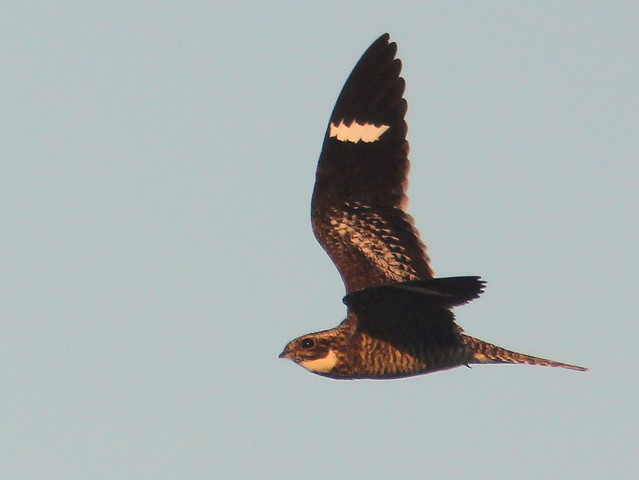
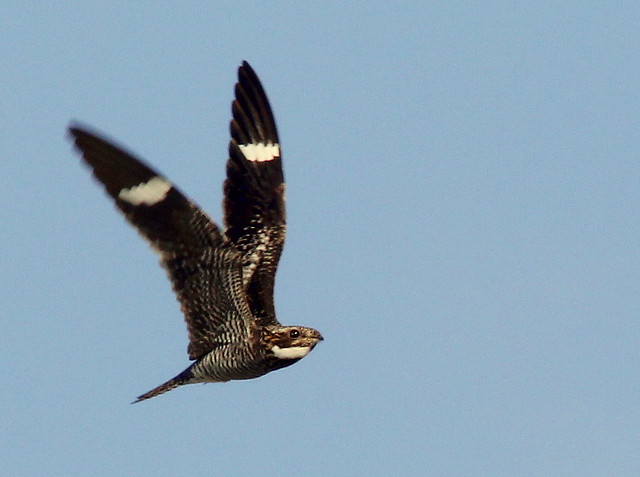
Since nighthawks are most active at the ends of the day, I am lucky when one banks to catch the rays of sunrise on a wing surface. 

Nighthawks usually land on the ground, but may perch lengthwise along a branch or even a utility line.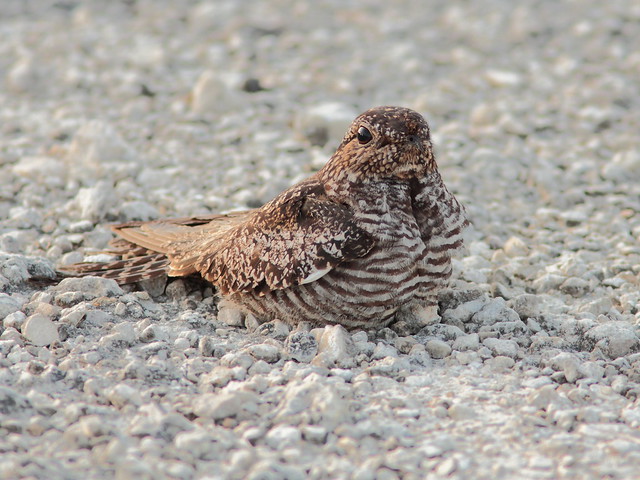
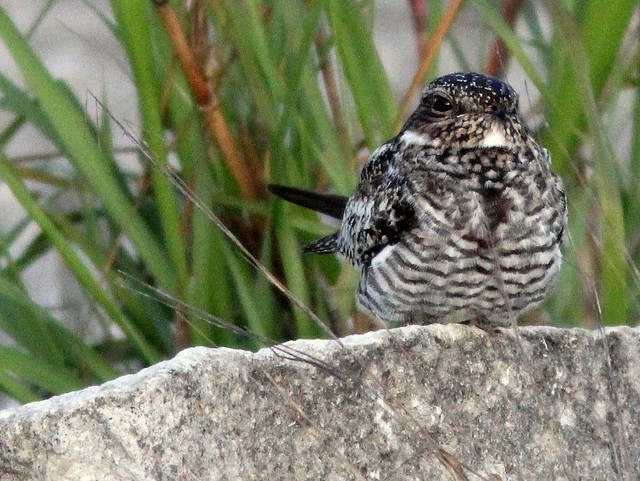

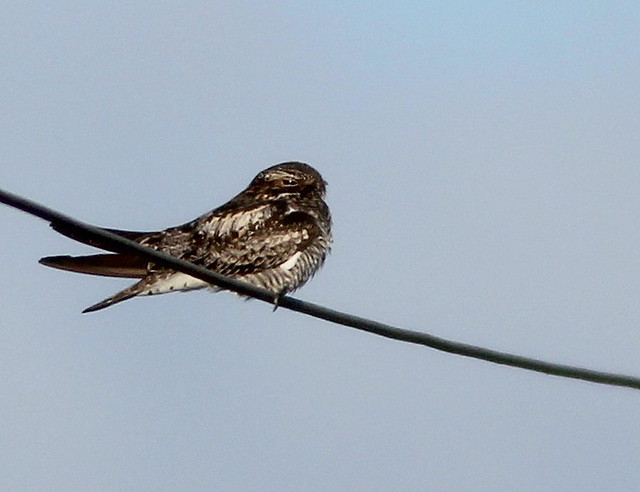
This past week, a few days before we returned to Illinois from Florida for the second time this year, we found the nest of a Common Nighthawk. A nighthawk flew up some distance ahead of us as we walked along the edge of the gravel road that leads into our local wetlands patch. I fixed my eyes on the exact spot where it had been resting, and, standing back on the road several feet away, we methodically searched for its nest.
Nighthawk eggs and chicks blend in perfectly with the pattern of pebbles and stones, and it would be very easy to step on them if we did not place each step very carefully. I found the nesting site (it cannot be called a “nest” as it had no visible structure) next to a small tuft of grass, quite dangerously near the tracks of deer, raccoons, bicycles and joggers.
The eggs were set apart from each other, suggesting that the adult may have been shading them from the sun rather than incubating them.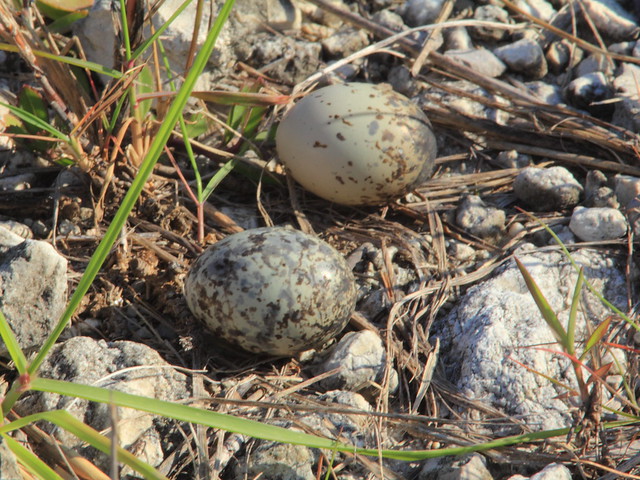
The next morning the eggs were close together. Nighthawks have been known to move their eggs some distance, clearing larger stones out of their path as they rolled them. In his classic Life Histories of Familiar North American Birds, Arthur C. Bent writes:
The eggs do not necessarily remain in the position in which they are first laid, especially when the nesting site is on a comparatively level surface such as that provided by graveled roofs. During the period of incubation of two nests under daily observation, the eggs were gradually moved a distance of 5 to 6 feet. This shift in position comes about by the habit of the female pulling or pushing the eggs under her breast, thus moving them a short distance each time she settled on the eggs. As the direction of the bird’s approach was more or less constant, the eggs were moved in the same general direction. This resulted in a distinct trail being formed, giving an appearance that one would expect to see if a giant snail had traveled over the graveled surface and forced the larger pebbles to one side. B. H. Warren (1890) writes that the eggs of a nighthawk in one instance were moved 200 feet by the bird, which carried them in her mouth. I have never been able to verify this extraordinary behavior of a nighthawk transporting an object as large as an egg in its mouth. (http://birdsbybent.netfirms.com/ch11-20/nighthawk.html)
We retreated as the parent bird returned to shelter the eggs, and photographed her (or him, as both sexes take part in incubation) on the nest site.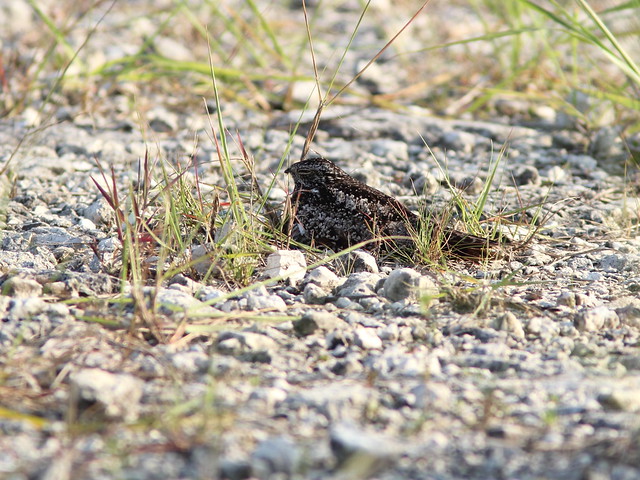
The next morning, Mary Lou was ahead of me as we walked along the gravel road. Suddenly she was startled when a nighthawk flew up right in front of her. It actually flew towards her, then fell to the ground, flopping and rolling as if in agony. It was obviously performing a distraction display, and the amount of energy that went into it suggested that Mary Lou had nearly stepped on the eggs (or more likely young birds). I had to set the camera on macro to get these shots, as the bird allowed a very close approach before moving away. We briefly examined the area from a safe distance but did not see any eggs or young– not surprising, as they are well camouflaged. 
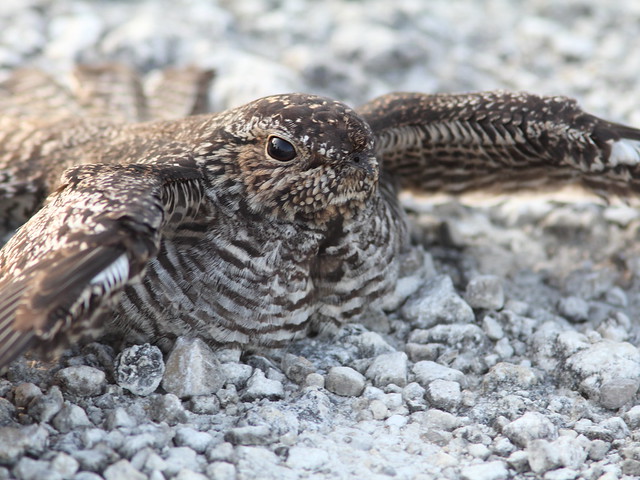
The bird was obviously under great stress, so we did not remain there very long. As we walked away it resumed a more normal posture and flew back to the nesting area. In the meantime, its mate had been flying back and forth on the opposite side of the road, issuing soft calls that sounded like “kwoo,” quite unlike the familiar loud and shrill “peent” that we often hear from flying nighthawks.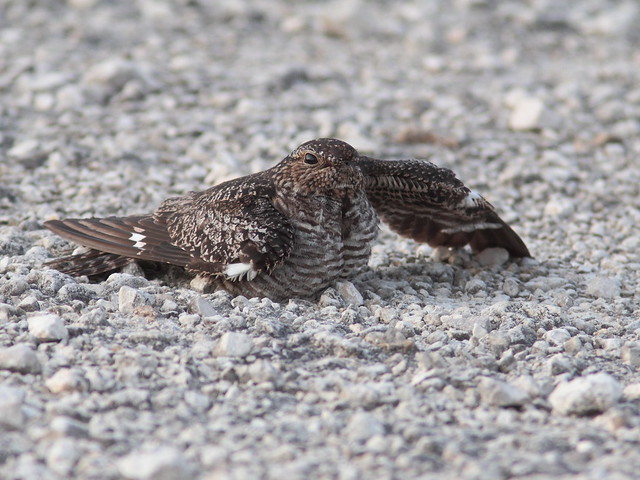













June 17th, 2012 at 10:03 am Wonderful post, Ken! Fabulous images and much new information. I have only seen them during the migration and the way they are camouflaged there is little chance I’ll ever see one close up.
June 18th, 2012 at 9:30 pm Ken — I LOVE this post — nighthawks were the first bird that ever got my interest, way back when I was a child in Eastern Washington, but nobody was a birder….I didn’t identify it until many years later and I was so excited, you’d think I would have discovered an Ivory Bill woodpecker!
June 19th, 2012 at 9:52 am Lovely photos! Great post for WBW!
June 19th, 2012 at 10:08 am I love your Nighthawk post and the flight shots are amazing!!!Have a great day! Shantana
June 19th, 2012 at 10:55 am Beautiful series on the nighthawks!! Boom & Gary of the Vermilon River, Canada.
June 19th, 2012 at 11:37 am Amazing captures Ken, there is something special about those flashing wing bars and that eractic bat like flight path, what a photographic challenge! All this and Egg shots too?!! Bravo!
June 19th, 2012 at 2:00 pm Great photos - especially the in-flight ones. It sounds like a very interesting bird.
June 19th, 2012 at 2:54 pm how awesome! such cool birds! we get the whippoorwills - mostly heard but on rare occasions, seen. :)
June 19th, 2012 at 3:57 pm They are cool birds, your photos are always amazing. Great sightings of the Nighthawks.
June 19th, 2012 at 4:42 pm Super post Ken! I love all the Common Nighthawk images and the information is great. Isn’t it amazing how different the eggs look?
June 20th, 2012 at 9:40 am I have never seen a Nighthawk to my knowledge, possibly in flight once, but oh to see one as you have…what a thrill that would be. They remind me a bit of Swallows as in their appearance, as well as their great camouflage reminds me of Whippoorwills and Chuck-will-widows. Wonderful share~~
June 20th, 2012 at 10:13 am Wow What an incredble post. Stunning pictures and what fortune for you to be able to encounter such a species. I was able to watch a Short tailed Nighthawk at close quarters in Venezuela but always in the murky light of the dawn awaking so to see these shots is fab Dave
June 20th, 2012 at 1:30 pm What an interesting post about a fascinating bird! Your photos are wonderful.
June 21st, 2012 at 1:20 pm A fantastic bird and superb shots.
June 28th, 2012 at 10:07 am Thanks, all for your encouraging comments. I really enjoyed my encounters with the nighthawks.
July 2nd, 2012 at 6:37 pm Hi Ken — I just read this old post of yours. I posted my nighthawk story quite a while ago and I wanted to share it with you. (Hopefully the link above will take you to it.) I loved that this bird is one of the first you remember as it was for me! (Your pictures are 1,000 X better– at least)….I really loved this post and am glad I came back to read it.
July 3rd, 2012 at 2:29 pm @Sallie– That is really great to hear that a nighthawk was someone else’s first “real” bird, not counting pigeons, starlings and House Sparrows (I called the latter two “blackbirds” and “chippies’). I enjoyed your post, too. Thank you!